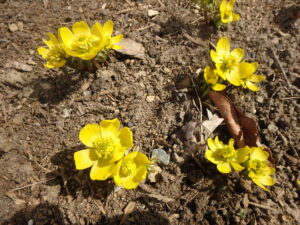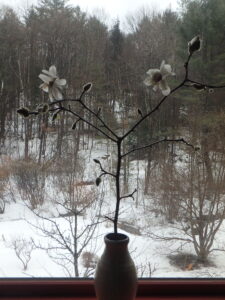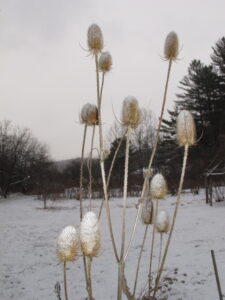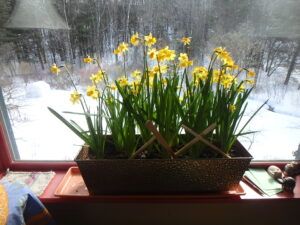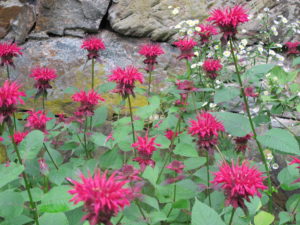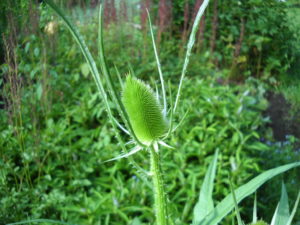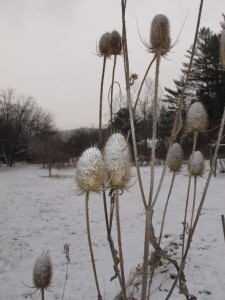Arrangements for Early Spring
I miss being able to go to my garden and pick flowers for the table. Yes, spring is on the way and even feels present on good days now. But it will be awhile until my daffodils and tulips bloom. My winter aconite, small yellow bulb flowers, are blooming, and little white snowdrops have pushed through frozen earth. Those mini-flowers aren’t really suitable for a bouquet, but I’ve picked a few things that please me.
First, I picked some stems from my ‘Merrill’ magnolia. It is loaded with fuzzy buds for its late-April blooming, and these look good in an arrangement. Magnolia branches tend to fork and grow in different directions, so placing stems in a vase can be tricky. I put some in a dry vase with dried flowers and seed-bearing stems and one in a vase with water to put on a windowsill. The buds I picked on January 31 bloomed on March 17.
Then there are the hydrangeas. Many species and varieties hold onto their flower panicles well into winter and can be quite nice in a vase. My favorite is one called ‘Pink Diamond’. It has long stems and it holds onto the fertile and infertile inflorescences, showing contrast between white and black florets on the panicles. Although the blossoms are pink toward the end of their bloom cycle, they are not pink after frost.
Astilbes bloom magnificently for me, and their winter stems are great in a dry vase. I have many different species and varieties ranging from short (12-inch blossom stems) to tall (48-inches). Their chief requirement is moist soil, and I have plenty of that. If you don’t have moist soil, the leaves will brown up in the heat of summer. One trick I have tried in dry locations is to bury a plastic bag a foot or so deep in the soil before planting. That will act like a little bathtub and hold some water in dry times. They like a half day of sunshine, and prefer morning sun.
Of course, the best color in the house for me right now are my forced daffodils. Last fall I potted up plenty of “tete-a-tete” daffodils and kept them in my cold cellar until recently. Each bulb provided many blossoms and even now, after the flowers have gone by, they are still pleasant looking with green leaves and dried yellow flowers.
When Good Flowers Get Out of Control
Every garden has a few thugs. Nice flowers with handsome blooms that somehow get too rambunctious and take over. They can choke out other plants as easily as weeds. That happens, in part, because we are reluctant to pull them. In general, they have roots that extend and send up new shoots. Let’s look at a few.
I recently pulled up a lot of beebalm (Monarda didyma). That was tough for me to do because it is such a great flower, and it has not yet bloomed. But it had run roughshod over most of one large flower bed, and it had to be brought under control.
Beebalm likes morning sunshine and soil that does not dry out completely. There is also a native beebalm (Monarda fistulosa) that I’ve seen wild in the Mid-west and Rockies. It is shorter, and has pale lavender colored flowers. It does well in hot, dry locations. Our garden beebalm comes in six or more colors from purple to pink – but it does best out of the hot afternoon sun. It sends roots up to a couple of feet, and because it is tall, it can shade-out and out-compete other flowers. As the Red Queen in Alice in Wonderland pronounce, “Off with her head!”
For removing any plant with extended roots, I like the CobraHead weeder. It is curved like a single steel finger, and can be used to loosen the soil under and around weed (or thug-like flower) roots. I gently tug on the flower stem, while loosening the roots. Beebalm, like most plants with long roots, has nodules in the roots. If you break the root, new plant stems will grow from a nodule.
Another difficult plant is Obedient Plant (Physostegia virginiana). What a funny name for a plant that is not the slightest bit obedient. Its roots are problematic because they break so easily, more so than any other plant I know. They send down a tap root that breaks off, even if you have loosened the soil. And it can take over a garden in just a season! I no longer allow it in any of my garden beds, but have moved some to the edge of the woods where deep shade on one side, and lawn on the other, can control it.
All that said, Obedient Plant is a lovely cut flower. It has strong square stems (like mints), and for me it grows up to 5 or 6 feet tall. It lasts well in a vase, with pink or white spikes of many small flowers. I had it in full sun in rich, moist soil, and it ran like crazy!
There is a form of Obedient Plant that has green and white leaves, and it is much more obedient! Like any variegated-leafed plant, this one has less vigor because it has less green chlorophyll to make the food that feeds the roots and flowers. I grow this one, though I find I often need to stake it to keep the flower stems from flopping over.
Another potential thug that I allow in my garden is common teasel (Dipsacus fullonum). Hated by corn farmers in the Mid-West as an invasive weed, it spreads by seed, not root. It’s a biennial. The first year of its life it does not flower, but produces distinctive long, light-green leaves (often with little wart-like bumps) in a low rosette. The second year it sends up a flower stalk up to 6 or 7 feet tall, and produces a seed head that is like a piece of sculpture.
Individual teasel flowers are very small and a light purple, but they don’t all appear at once. Bees love them! The seed head is very showy, a 2-inch spiny extravaganza that looks great in a vase as a cut flower, or later as a dried flower. I wear leather gloves to pick it, and then rub off the spines on the stems for use in vases.
The key to controlling teasel is to learn to recognize and pull the first year plants. That, and picking the stems with flowers before they distribute seeds. I suppose I will get e-mail telling me how stupid I am for allowing this thug in my garden, but I have been able to keep it under control – and I introduced it 20 years ago! Don’t introduce it to your garden unless you can pay attention to it, and keep it controlled.
Sometimes we make mistakes. We see a well-controlled plant blooming in its pot and buy one (or more). We put it in the garden, and only later decide that it has some bad qualities. It has taken me a long time to realize that it’s great to recognize that a plant is not for me, and then be able to dig it up and toss it into the compost.
I recently needed space for a new plant, and decided that I did not like my Siberian Bugloss (Brunnera siberica). I bought it because I have another species of Bugloss (B. macrophylla) that I like a lot. ‘Jack Frost’ Brunnera has lovely small blue flowers in spring and low green and white leaves all summer. But the Siberian relative does not stay in a compact mound, and is a bit floppy. So I yanked it in favor of something new.
Call me fickle if you wish, but I have a limited amount of garden space, and I reserve the right to remove any plant that does not, at least occasionally, cause me to say with glee, “I love that plant!”
Read Henry’s twice-weekly blog posts at https://dailyuv.com/
Holiday Decorations
This time of year is tough on many gardeners: there is little daylight and little to do in the garden. And there are no flowers to pick and place on the table. Recently the weather has been dismal: dark gray days with precipitation off and on. Over the centuries people have combated the darkness with candles, bonfires, holiday lights and sprigs of greenery placed on the door or brought inside. Let’s look at what we can do.
First, I regularly visit my local independent florist. Florists are a dying breed, along with independent bookstores and family-owned hardware stores. Call me an old codger, but I believe that there is value in supporting all of these institutions, even if I pay a dollar or two more for what I buy. The owners of these institutions have a wealth of knowledge, and are happy to help you find just what you need. And often their prices and quality are actually better.
For example, I believe that the flowers I get from my florist last longer and look better than flowers bought at a big box store. I ask my florist to put together a bouquet of flowers for me, and she picks a nice selection – $10 will usually buy a generous bouquet.
Keeping the bouquet fresh takes regular maintenance: I change the water every day or two, and trim off half an inch of stem each time. It’s also important to remove all leaves that might get into the water. When the leaves die, bacteria grow and slime forms – blocking the uptake of water to the flowers. So they wilt.
A few years ago I called my florist to see if she had any potted phalaenopsis orchids for sale. Surprisingly, she told me to go to a big box store, and I did. I was amazed to see them for sale under $15. Certain big box stores obviously have suppliers who sell them truck loads of these hardy and gorgeous orchids. So most florists don’t even try to compete.
Phalaenopsis orchids are relatively easy to maintain and can be coaxed to produce more blossoms in future years. They want bright diffuse light: a table top in a bright room is fine. The key is to avoid overwatering. These orchids are sold growing in a fast-draining bark mixture without soil. The roots are in a plastic mesh pot with holes which sits inside a ‘cache’ pot that has no drainage hole. I lift the inner pot out of the outer, and allow water to run through the bark chips once a week. I allow it to drain, then return it to the cache pot. If you water the plant in the outer pot, it collects water at the base – eventually drowning your orchid.
I also scavenge twigs, branches, dry flowers and berries to add to flower arrangements, or to create arrangements in their own right. Each fall I cut hydrangea blossoms and store them in tall flower pots without water. They last well all winter.
Teasel is a dreaded weed for corn farmers in the Midwest, but I grow a few plants each summer and use it as a dry flower in winter arrangements. This plant is biennial, meaning that it blooms in its second year of life, and then dies. It gets to be over 6 feet tall and displays wonderful seed pods that have sharp barbs and spines. The key is to learn to identify the first year plants, so that you can weed out most of them before they mature.
Evergreen boughs are nice indoors at this time of year. Just be careful where you make your cuts. Never take the top of a small tree, or the tip of a prominent branch. Most do not replace the missing branch, or will send out several new branches instead of just one. So you can spoil the look of your evergreen by snipping branches carelessly. Cut inner branches, or take pieces from inconspicuous places.
Canadian hemlock is plentiful in woods everywhere, but the needles do not last well indoors. (Identify them by their short, flat needles). Your best bet is to buy a Christmas tree that is a little too tall – and the cut off branches at the base to use in vases or swags. White pine lasts well in a vase and is very common (Identify them by their 5 long, soft needles per cluster of needles, one for each letter in w-h-i-t-e).
Of the berries, the brightest and best looking is winterberry (Ilex verticillata), our native deciduous holly. These are understory trees or tall shrubs that grow wild in wet places and swamps, but also make satisfactory garden plants. They are dioecious, which means you need a boy bush to go with the females – or no berries. The berries are commonly sold by florists and grocers, and look great – though they tend to drop a few berries on the table before long. I don’t know how to keep that from happening. (Tell me if you do, please).
Last but not least, I am cheered up by outdoor winter lights. In recent years the industry has come up with LED lights that use almost no electricity – less than 5 watts a string instead of the 5 watts a bulb we had in my youth. So I place them in my garden on trees and shrubs and run them late into the winter. It’s all part staying cheerful while living in the Great North.
Henry Homeyer lives in Cornish flat, NH. You may reach him through his web sites: www.henryhomeyer.com or www.Gardening-guy.com.



